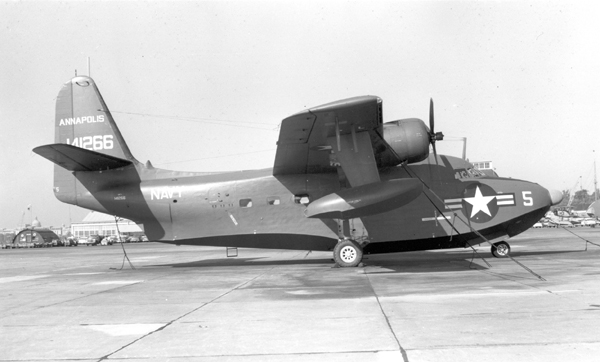Albatross/Goat

| In November 1944, the U.S. Navy placed an
order with Grumman Aircraft for two Model G-64 amphibians, designated
XJR2F-1 Pelican. These aircraft were to be successors to the JRF Goose
utility amphibian but they would be larger, have more powerful engines
and possess all-weather capability. The first flight was on 1 October
1947; the second prototype was delivered in May 1948. When the U.S. Air Force was established in September 1947, it was tasked with providing worldwide air-sea rescue (ASR) and they needed a new aircraft to accomplish their mission. In May 1948, the U.S. Navy placed an order with Grumman for 58 production G-64s with the name "Albatross." The order included 32 PF-1A patrol amphibians and six UF-1 utility aircraft for the USN and 20 SA-16A ASR aircraft for the USAF. In November 1948, the USN ordered 167 Martin P5M-1 Marlins and because this aircraft was superior to the PF-1A in the maritime reconnaissance role, the Navy lost interest in the PF-1A and all were delivered to the USAF as SA-16As. The SA-16A made its first flight on 20 July 1949. The Navy's first UF-1 made its first flight on 30 December 1949. The Navy went on to receive a total of 94 UF-1s for use as utility transports. Variants of the UF-1 were the 83 UF-1Gs for the U.S. Coast Guard. Thirty one were ordered by the Navy and transferred, 15 were ordered by the USAF and transferred, and 37 were USAF SA-16As transferred to the Coast Guard. The two UF-1Ls were winterized aircraft for use during Operation "Deep Freeze" in Antarctica and the five UF-1Ts were UF-1s modified as navigation trainers and delivered to the U.S. Naval Academy at Annapolis, Maryland. In April 1955, the USAF approached Grumman with a request to modify their SA-16As to significantly improve the performance at the least possible cost. The Grumman Design G-111 called for a longer wing, increased fuel, changes to the vertical and horizontal tail surfaces and the wings. The USAF approved the changes and 86 SA-16As were modified to SA-16Bs beginning in January 1956. The USN and USCG also used a modified aircraft similar to the SA-16B but built to the Grumman G-211 design number. Thirty three UF-1s were modified to UF-2s; 19 other aircraft intended for transfer to foreign countries were also designated UF-2s. The USCG modified 78 of their UF-1Gs to the SA-16B standard and these were designated UF-2Gs. In 1962, the three branches of the U.S. military introduced a new tri-service system of identifying aircraft. All UFs and SA-16s in service on that date were re-designated U-16s. The new designations were: HU-16A: All remaining USAF SA-16As HU-16B: All remaining USAF SA-16Bs HU-16C: All remaining USN UF-1s LU-16C: All remaining USN UF-1Ls TU-16C: All remaining USN UF-1Ts HU-16D: All remaining USN UF-2s HU-16E: All remaining USCG UF-2Gs By Jack McKillop |
| "A" Model | "B" Model | |
|---|---|---|
| Length | 60' 7" | 62' 9" |
| Wingspan | 80' 0" | 96' 8" |
| Height | 24' 5" | 25' 10" |
| Horiz Stab | 29' 0" | 31' 0" |
| Wing Area | 883 sq ft | 1,035 sq ft |
| Beam | 7' 11" | 7' 11" |
| Main Gear Track | 17' 8" | 17' 8" |
| Service Ceiling | 25,000 ft | 25,000 ft |
| Empty Weight | 20,800 lbs | |
| Max TOW | ||
| - Land | 33,000 lbs | |
| - Water | 29,500 lbs | |
| - Triphibian | 29,000 lbs | |
| Fuel Capacity | ||
| "A" Model | "B" Model | |
| Wing Tanks | 675 gal | 675 gal |
| Floats - ea | 210 gal | 210 gal |
| Total Internal | 1,095 gal | 1,095 gal |
| Ext tanks | ||
| - MK8 | 300 gal | 300 gal |
| - MK12 | 150 gal | 150 gal |
| - MK4 | 100 gal | 100 gal |
| Engines | ||
| "A" Model | "B" Model | |
| Model | R-1820-76 | R-1820-76 |
| - HP | 1,425 HP | 1,425 HP |
| Model | R-1820-82 | R-1820-82 |
| - HP | 1,525 HP | 1,525 HP |
| Propellers | ||
| Model | Hamilton
43D50 - 3 Blade |
Hamilton
43D50 - 3 Blade |
| Diameter | 11 ft | 11 ft |
| Ground Clearance | 8 ft | 8 ft |
| Water Clearance | 4 ft | 4 ft |